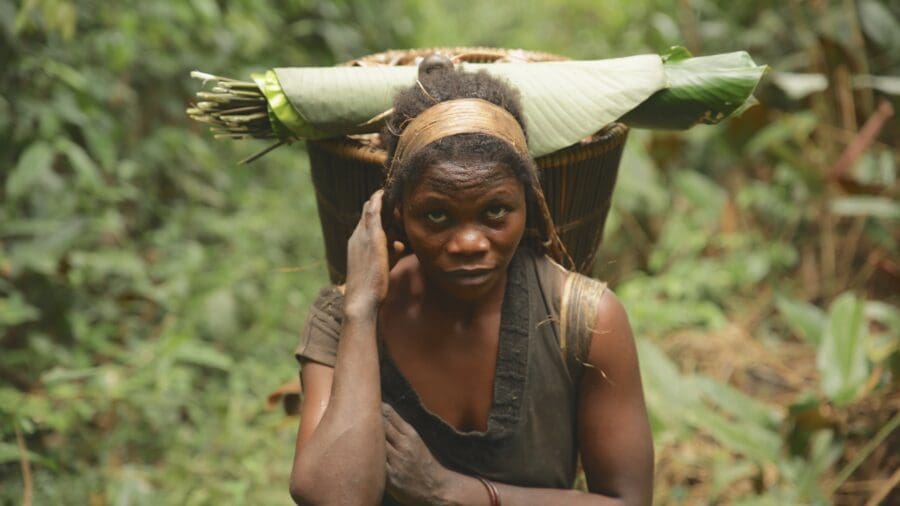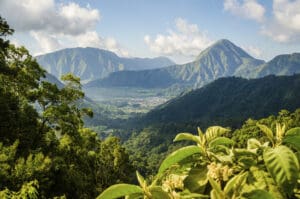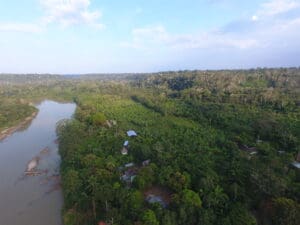New analysis reveals that Indigenous Peoples and local communities manage 300,000 million metric tons of carbon in their trees and soil—33 times energy emissions from 2017
For more information, please contact:
Coimbra Sirica: [email protected]; +1 301 943 3287
Wanda Bautista: [email protected]; +1 302 233 5438
Jamie Kalliongis: [email protected]; +1 314 651 7497
SAN FRANCISCO, CA (10 September 2018)—Researchers today released a report showing that Indigenous Peoples and local communities worldwide manage massive amounts of carbon in the trees and soil of their forests, yet governments largely fail to recognize their rights to the lands they have cared for, sometimes for millennia.
The new carbon analysis reports a total of 293,061 million metric tons of carbon held aboveground, belowground, and in the soil beneath forests managed by indigenous and local communities worldwide. The study of 64 countries, representing 69 percent of forest carbon globally, shows that communities protect five times more carbon than demonstrated by a previous analysis, which focused only on aboveground tropical forest carbon.
The findings of a second paper from the Rights and Resources Initiative (RRI) found that tropical forest governments are failing to act on evidence that legally recognized indigenous and community forests tend to store more carbon and experience lower rates of deforestation than other forests. While the forest area recognized for communities has grown nearly 40 percent since 2002—to a total of 15 percent of forests globally—the pace of recognition since 2008 has remained slow, just as the need for climate solutions has become more urgent than ever.
“Evidence from the last decade shows that developing country governments and the broader international community are not moving fast enough to recognize and strengthen the rights of forest peoples,” said Alain Frechette, an author of the carbon analysis and director for strategic analysis and global engagement at RRI. “This is incredibly problematic in the context of climate change. As our research shows, at least one-third of the carbon managed by communities in tropical and subtropical countries lies in forests where the primary stewards lack legal titles, putting them, their forests and the carbon they store at great risk.”
Released on the eve of the Global Climate Action Summit in San Francisco, the carbon analysis presents the most comprehensive assessment to date of carbon storage on community lands worldwide. It draws on newly developed global estimates of carbon stored in trees, roots and soil, and is the result of a collaboration of researchers with RRI, the Environmental Defense Fund, the Woods Hole Research Center, the World Resources Institute, and LandMark, with contributions from three indigenous organizations, the Coordinator of the Indigenous Peoples of the Amazon Basin (COICA), the Mesoamerican Alliance for Peoples and Forests (AMPB), and the Indigenous Peoples’ Alliance of the Archipelago (AMAN).
“The international community is struggling to save forests and to stop climate change,” said Rukka Sombolinggi, secretary general of AMAN. “This new research shows that by respecting our rights to our forests and lands, you not only protect the carbon stored in the trees, you prevent the release of vast reservoirs of carbon beneath our feet. So the solution is to recognize our rights.”
Scientists estimate that protecting forests and investing in reforestation between now and 2030 could contribute up to 37 percent of the solution for limiting the global rise in temperature to 2 degrees Centigrade. They also warn that tree cover loss in tropical countries around the globe has been rising steadily over the past 17 years. In 2017, for instance, the tropics lost 15.8 million hectares (39.0 million acres) of tree cover, an area the size of Bangladesh
The carbon analysis adds to a growing body of evidence that recognizing strong rights to community lands is an affordable, technology-free solution to reducing deforestation. The rate of tree cover loss is less than half in community and indigenous lands compared to elsewhere, according to an analysis of the data from the Global Forest Watch. Where rights are recognized, the difference is even greater.
The findings represent the first global baseline assessment of carbon stored above and below ground—including in the root biomass and soil organic matter—of community-managed lands across tropical, subtropical, temperate and boreal zones. Based on several newly available global data sets, the authors report a five-fold increase from their previous estimates of how much carbon Indigenous Peoples and local communities manage on their lands.
“Soil organic carbon accounts for a significant, but not unexpected, fraction of the carbon stored globally in forests managed by Indigenous Peoples and local communities,” Wayne Walker from Woods Hole Research Center said. “Soil alone accounts for 65 percent of the carbon stored in tropical forests managed by these groups, and these vast below ground carbon reservoirs can be preserved and protected only as long as the forest above remains intact.”
Land rights underused as solution to stopping deforestation, preventing carbon release
RRI’s forest tenure report covers 58 countries representing 92 percent of the world’s forests, showing that in 2017, the total forest area designated for and owned by Indigenous Peoples and local communities is 528 million hectares. For the 41 countries that RRI has tracked since 2002, the updated analysis reveals that Indigenous Peoples and local communities legally own or have rights to only 15 percent (521 million hectares) of the forest area of those countries—an increase of 147 million hectares (40 percent) since 2002.
The study finds that communities whose territories were recognized for the first time between 2013 and 2017 were largely acknowledged as forest owners rather than as mere holders of usage rights, a significant change from the previous five years. However, the report concludes that the rate of government recognition of the rights of Indigenous Peoples and local communities since 2008 is significantly lower than it had been between 2002 and 2008.
“While it is clear that governments are not moving quickly enough to recognize the rights of Indigenous Peoples and local communities, our findings may well signal a new trend toward recognition of rights that are stronger and more robust,” said Chloe Ginsburg of RRI, an author of the forest tenure study. “We’re hopeful that policymakers will continue to gain awareness of the benefits of recognizing rights—to livelihoods, the climate and related sustainable development goals.”
Promising trend in Latin America endangered by rise in violence
The recognition of community tenure rights has increased significantly across Latin America since 2002. Of the forest area recognized across 41 countries over the last fifteen years, 49 percent of these forests were recognized for Indigenous Peoples and local communities in Brazil, and four other Amazon countries—Bolivia, Colombia, Guyana, and Peru—account for nearly 17 percent of the forest area recognized for communities over this period.
But the progress in Amazon countries is fragile, according to UN Special Rapporteur on the Rights of Indigenous Rights, Victoria Tauli-Corpuz. Citing research showing that 2017 was the deadliest year on record for land and environmental defenders, Tauli-Corpuz notes that resistance to recognizing the community rights of Indigenous Peoples and failure to protect existing rights is driving a human rights crisis.
This month, Tauli-Corpuz will present new findings documenting a significant increase in the violence and criminalization Indigenous Peoples often face when they try to stop the destruction of their territories.
“Led by Brazil, Indigenous Peoples in the Amazon have made more progress in gaining recognition of the rights of Indigenous Peoples and local communities than any other region,” Tauli-Corpuz said. “But the flip side of the coin is that these are also the countries where rights are under siege, and where indigenous leaders and environmental defenders are more likely to be assassinated or criminalized. We have a long way to go.”
Researchers say carbon in community forests may be far greater than estimates
In their analysis, the researchers note that the 293,061 million metric tons stored in the community forests is equivalent to 33 times the global energy emissions for 2017.
The study relies on newly generated global carbon density data from WHRC, updated forest tenure data from RRI, spatially explicit land tenure data from the WRI’s LandMark, and recently produced spatial data from an ongoing collaboration with AMAN to create the most current and accurate assessment of carbon stored in indigenous and local community lands and forests.
Yet the authors say they are likely to be vastly underreporting the true amount, particularly in regions where local peoples’ rights to their forests are not recognized.
“This assessment remains an underestimate of carbon stored in collective forestlands worldwide,” the study finds.
“The full extent of forests and other lands held by indigenous and local communities—and particularly those where communities have yet to achieve formal recognition of their rights—is unknown and spatially explicit data concerning these areas is limited. Thus, vast stores of carbon in carbon-rich countries such as Indonesia and the Democratic Republic of the Congo remain undocumented.”
###
The Rights and Resources Initiative (RRI) is a global coalition consisting of 15 Partners, 7 Affiliated Networks, 14 International Fellows, and more than 150 collaborating international, regional, and community organizations dedicated to advancing the forestland and resource rights of Indigenous Peoples and local communities. RRI leverages the capacity and expertise of coalition members to promote secure local land and resource rights and catalyze progressive policy and market reforms. For more information, please visit www.rightsandresources.org.





